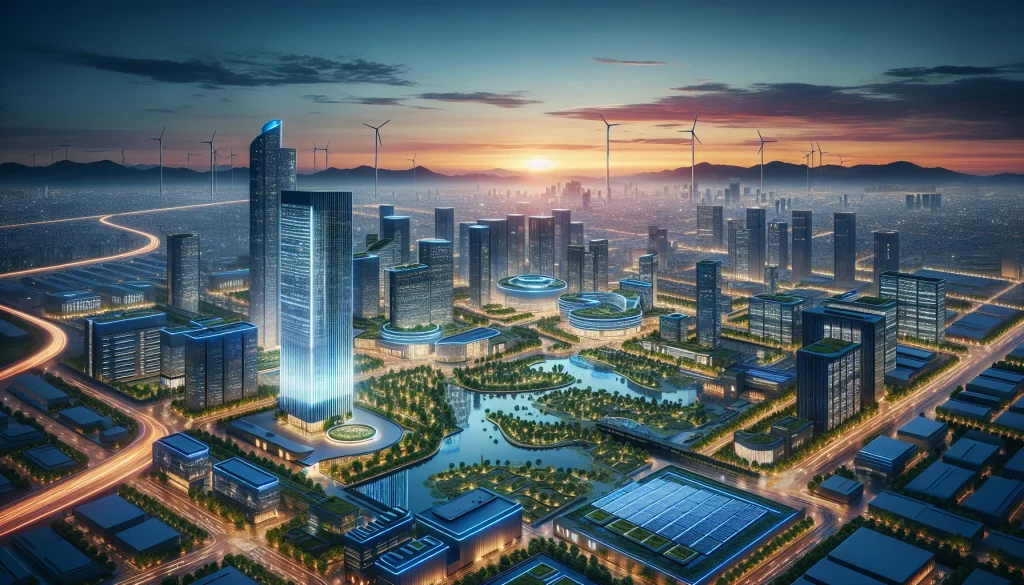Discover how smart infrastructure is reshaping urban environments for a sustainable future. This article presents cutting-edge examples of technology-driven solutions that address pressing environmental challenges. Drawing on insights from industry experts, learn about innovative approaches to waste management, energy efficiency, and pollution reduction that are transforming cities worldwide.
- Smart Waste Management Reduces Environmental Impact
- IoT Streetlights Optimize Urban Energy Consumption
- AI-Powered Grids Enhance Renewable Energy Integration
- Real-Time Monitoring Transforms Urban Energy Management
- Sensor-Based Water Systems Combat Drought
- Adaptive Irrigation Revolutionizes Water Conservation
- Smart Traffic Control Decreases Emissions
- IoT Sensors Drive Mexico City’s Pollution Reduction
- AirBubble Playground Filters Air Through Play
Smart Waste Management Reduces Environmental Impact
One of the most impactful ways I’ve seen smart infrastructure contribute to environmental sustainability is through the integration of sensor-based waste collection and routing systems. At Frontier Waste Solutions, we’ve begun leveraging these technologies to create more responsive, efficient, and environmentally responsible waste collection services—especially critical in the fast-growing regions of Texas where population surges can quickly outpace legacy infrastructure.
By implementing smart routing platforms and real-time fill-level sensors in commercial and residential containers, we’re able to reduce unnecessary collection trips, lower fuel consumption, and decrease overall vehicle emissions. This data-driven approach not only improves our operational efficiency but directly supports our commitment to environmental stewardship by cutting down on greenhouse gas emissions and prolonging the lifespan of our fleet.
Technology also enhances transparency and education. With customer-facing platforms, we can share insights about recycling contamination rates, diversion goals, and sustainability benchmarks—encouraging more informed participation from residents and municipalities. These tools empower communities to make environmentally conscious decisions while holding all stakeholders, including haulers, accountable to measurable outcomes.
In a broader sense, smart infrastructure enables a shift from reactive to proactive waste management. It positions us to meet the environmental expectations of both municipalities and private equity stakeholders while maintaining the level of service and dependability that’s central to Frontier’s reputation.
Smart systems, when aligned with sustainability goals, don’t just improve performance—they help create a more resilient and environmentally conscious waste ecosystem for Texas and beyond.
 John Gustafson
John Gustafson
Founder, President & CEO, Frontier Waste Solutions
IoT Streetlights Optimize Urban Energy Consumption
One of the clearest examples I’ve seen is the use of smart sensors and AI in optimizing city-wide energy consumption, especially in public infrastructure like street lighting and water systems. In one project I consulted on years back, an urban development team used IoT-enabled streetlights that adjusted brightness based on real-time foot traffic and ambient light. Not only did it reduce electricity usage significantly, but it also lowered carbon emissions by cutting waste at scale.
The beauty of technology is that when it’s used intentionally, it can turn an everyday system into something self-regulating and resource-efficient. From smart grids to AI-powered irrigation, the opportunities to align infrastructure with sustainability goals are massive—and honestly, necessary. The key isn’t just to build smart, but to build with environmental accountability baked in from day one.
 Daniel Haiem
Daniel Haiem
CEO, App Makers LA
AI-Powered Grids Enhance Renewable Energy Integration
One of the most impactful ways we’ve seen smart infrastructure contribute to environmental sustainability is through the use of smart grids in energy systems. We’ve worked with clients who are involved in projects that integrate real-time data and advanced analytics to optimize energy distribution. By using sensors and AI, these systems predict and respond to energy demand, making it possible to minimize waste and enhance the efficiency of renewable energy integration, especially solar and wind. This kind of infrastructure reduces reliance on fossil fuels, lowers emissions, and makes the energy grid more adaptable and resilient.
We’ve also seen a lot of success in smart water management. Clients implementing IoT sensors and AI-powered systems to track water usage, detect leaks, and manage distribution have made huge strides in reducing waste. These technologies not only conserve water but also save energy, as less energy is needed to pump and treat water. It’s a simple yet incredibly effective way to address a growing issue, especially in regions where water scarcity is a major concern.
Technology is at the heart of so many sustainability projects we’re involved with at Leafr. We’ve seen energy-efficient building systems, like smart lighting, heating, and cooling, that adapt to real-time conditions, drastically reducing both energy consumption and carbon footprints. And predictive analytics that help industries anticipate and cut down on waste.
 Gus Bartholomew
Gus Bartholomew
Co-Founder, Leafr
Real-Time Monitoring Transforms Urban Energy Management
One of the most impactful contributions of smart infrastructure to environmental sustainability is the integration of real-time energy monitoring in large urban projects. Smart grids combined with IoT sensors in buildings allow cities to dynamically manage energy demand, shift usage during peak hours, and reduce reliance on fossil fuels. This isn’t theoretical—it’s happening in places like Singapore, where smart buildings are now cutting energy consumption by over 20% through AI-based optimization. That’s a concrete intersection of infrastructure and technology that benefits both the planet and operational efficiency.
Technology plays a deeper role beyond automation—it brings visibility and predictability. For instance, sensor-enabled water systems in drought-prone regions can detect leaks, forecast consumption patterns, and ensure better allocation of limited resources. These systems not only prevent wastage but also shift public infrastructure from reactive to proactive. Environmental sustainability depends on this shift—from maintenance to intelligence.
 Arvind Rongala
Arvind Rongala
CEO, Edstellar
Sensor-Based Water Systems Combat Drought
One of the most impactful smart infrastructure initiatives observed recently involves sensor-integrated water systems in drought-prone regions. These systems monitor usage patterns, detect leaks instantly, and automatically adjust water distribution to reduce waste. This kind of precision wasn’t possible a decade ago. It’s remarkable how real-time data is now driving tangible environmental outcomes—especially in areas where every drop matters.
Technology, when designed to be adaptive and unobtrusive, becomes a natural ally to the environment. Whether it’s AI optimizing energy consumption in data centers or smart grids balancing renewable energy flows, the key is integration without disruption. The sustainability gains often come from behind-the-scenes intelligence—not flashy hardware. That’s where long-term impact begins.
 Anupa Rongala
Anupa Rongala
CEO, Invensis Technologies
Adaptive Irrigation Revolutionizes Water Conservation
Smart irrigation systems are a quiet revolution in sustainability. I’ve seen cities retrofit public parks with sensor-based irrigation that adapts to real-time weather and soil conditions—eliminating massive water waste from overwatering. Instead of sticking to outdated fixed schedules, these systems only activate when necessary, which can cut water use by 30% or more. It’s a simple but powerful example of how tech doesn’t have to be flashy to be green—just smart enough to listen before it acts.
 Justin Belmont
Justin Belmont
Founder & CEO, Prose
Smart Traffic Control Decreases Emissions
Singapore uses an adaptive traffic signal control system called the Green Light Intelligent Driving Enhancer (GLIDE), which leverages real-time data from sensors, cameras, and AI to adjust signals based on current traffic flow. Less idling means fewer emissions—especially in dense urban areas.
Metro cities around the world are using smart traffic management systems to reduce stop-and-go congestion, prevent bottlenecks by distributing traffic more evenly, and decrease both travel time and fuel use.
According to research by Juniper, smart traffic technology could save up to 900 million tons of emissions globally. It’s a strong example of how infrastructure and technology can work together to support environmental sustainability.
 Kiel Kellow
Kiel Kellow
Business Owner, Kellow Construction
IoT Sensors Drive Mexico City’s Pollution Reduction
The combination of IoT air quality sensors with smart metering technology has created a smart infrastructure that promotes environmental sustainability throughout Mexico City. Authorities utilize real-time pollution data to implement vehicle restrictions and modify public transport systems for emission reduction in crucial regions. The Comisión Federal de Electricidad operates thousands of smart meters that monitor electricity usage and detect system losses while encouraging people to reduce their power consumption. The city demonstrates how technology can protect natural resources through its air pollution and carbon emission reduction while simultaneously delivering better energy reliability and system efficiency.
 Sebastian Garrido
Sebastian Garrido
Digital Marketing Manager, Vibe Adventures
AirBubble Playground Filters Air Through Play
The AirBubble playground filters the air while children play. It uses microalgae that absorb pollutants and release oxygen. The movement from children circulates air through the system, combining fun and sustainability together.
 Masa Awwad
Masa Awwad
Writer, Innovation Library







